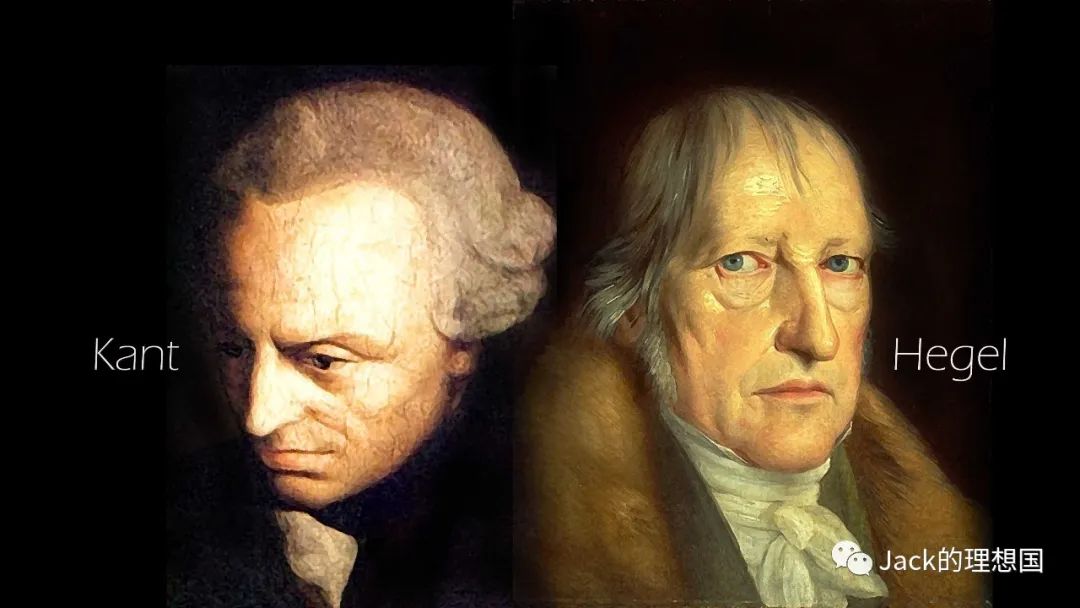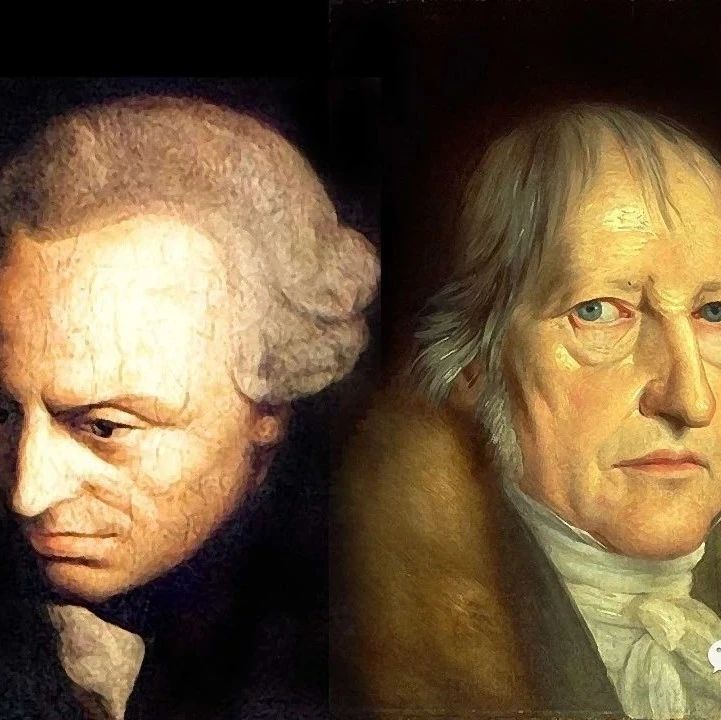Links Between East and West 40 Kant and Hegel 2 东西方的连接40 - 康德与黑格尔2

In Kant and Hegel’s narrations of history, conflict is not just a simple bypassing phenomenon that lends no meaning to the changes in cultures and civilizations. For both philosophers, conflict deserves great attention exactly because it has been one of the most pivotal factors in the unfolding of history.
In Kant’s philosophy of history, conflict should be perceived as an instrument employed by nature to push humankind to its ideal end. To break down this proposal, one must first understand the “end” that humankind is on a path to. In his political writings, Kant highlights a “perfect civil union” and “federalism of free states” as the ultimate forms of international order. In Kant’s schema of political development that leads to the “perfect civil union,” conflict occupies a key role. The fourth proposition in his essay “The Idea of a Universal History with a Cosmopolitan Purpose” gives a general overview of this argument: “The means which nature employs to bring about the development of innate capacities is that of antagonism within society, in so far as this antagonism becomes in the long run the cause of a law-governed social order." From this quote, Kant demonstrates his belief that a “law-governed social order” might eventually be achieved with the significant aid of the “antagonism within society,” the intrinsic cause of conflicts. Kant creates the term the “cunning of nature,” which refers to how conflict and social antagonism help individuals and states learn how and how not to treat one another, assisting their progress toward an ultimate end, although they are oblivious to this. In 1776, Kant claims, “The useful aim of philosophical history [in which conflict is indispensable and inevitable] consists of the preservation of good models and the display of instructive mistakes”. Over time, conflict gradually spurs societies to progress toward an international juridical condition in which the innate capacities of people (for example, the use of reason) can be realized, though many failures must happen in the process.
Two elements of Kant’s argument require further breakdown. First, how exactly does nature utilize war to progress the human social order? The answer to this question lies in human nature itself. For Kant, human nature’s design can be attributed to the work of a greater natural force at play throughout history. Nature implants the “unsocial sociability” characteristic into every man. With this characteristic, nature can initiate a cycle of conflict and peace. While the unsocial aspect of human nature tears people apart, triggering various kinds of conflict, eventually, people tend to come together socially. It prompts people to initiate discussions to end conflicts and rebuild a better-functioning social order. For Kant, wars appear to become more rational because they are waged after a more thorough consideration and with a more direct purpose. The trend of wars becoming more rational indicates that after many cycles of conflict and peace driven by people’s “unsocial sociability,” nature gradually shows humankind the costs of senseless warfare, making societies gradually more cautious about engaging in it.
A second element of Kant’s argument that should be examined more thoroughly is whether he possessed a “just war theory.” A “just war theory” sets up criteria to potentially justify war through a moral perspective. Such a theory additionally tries to politically justify war in certain circumstances. Some scholars, such as Brian Orend, have suggested that Kant does have a just war theory. They base their arguments on aspects of Kant’s argumentation. For example, he recognizes the need for civilians to arm themselves in special situations. However, this paper sides with the opposing cohort of scholars, including Howard Williams, in suggesting that Kant does not have such a theory. In Kant’s writings, as Williams interprets, “justice and war are in conflict with one another.” Kant does not justify war but merely argues that it is an inevitable and necessary step towards “a perpetual peace.” Furthermore, while he advocates for the right to self-defense, Kant stresses that this right is not unlimited – the use of force should be subject to legal and moral constraints.
Further, Kant openly advocates for the prevention of war in his essay “Perpetual Peace." The third preliminary article of perpetual peace between states is: “Standing armies will gradually be abolished together." Kant emphasizes this article because the existence of a standing army means that states can threaten others with war. He points this out in the essay by writing, “the armies are themselves the cause of wars of aggression which set out to end burdensome military expenditure." Hence, Kant views wars as destructive and something that should ultimately be prevented.
To complement the third article, the sixth preliminary article requires that “no state at war shall permit such acts of hostility as would make mutual confidence impossible during a future time of peace." This again indicates that Kant views peace as crucial. Additionally, inhis work Conjectures on the Beginnings of Human History, war is regarded as “the greatest evil." Kant believes war was only ever a necessary step towards peace, not a choice to be actively favored by states.
In Hegel’s philosophy, history is a series of constant conflicts moving human societies to the actualization of the Idea, the realization of the Spirit and freedom. Hegel points out clearly in Introduction to the Philosophy of History that human history can be regarded as totally rational, as it embodies Reason and aims to actualize the Spirit. Each conflict pushes societies closer to freedom. To better analyze the mechanisms of historical progression and the crucial role of conflict, Hegel creates a dialectical system to model his conflict theory. In his lectures on history, Hegel shows that dialectics, at its core, is an unfolding of thesis-antithesis-synthesis.[1] Every situation, or the thesis, intrinsically possesses its negation, or the antithesis. The clash of the thesis and antithesis brings forth a synthesis of the two forces as a temporary resolution. However, this synthesis will face its own antithesis as an objection. A synthesis (which becomes a new thesis) is a level higher than the previous thesis as it births itself from the merging of two opposing elements. This spiraling cycle goes on endlessly.
In Chapter Four of Introduction to the Philosophy of History, Hegel highlights the historical phenomenon of the Spirit self-perpetuating itself, then moving onto a higher level. In a similar sense, a conflict will unfold in a dialectical pattern. When B negates A, this means that these two sides are in conflict. If A is assumed to be the status quo, then B is its resistance; if A is the thesis, then B is its antithesis. Their clash would eventually result in a synthesis, which is a new status quo. This status quo advances from the previous one, though it will eventually face its own antithesis. Conflict, in a dialectical way, thus gradually elevates societies closer to the actualization of the Spirit.
A minor point to examine in Hegel’s conflict theory is the specific role of “world-historical individuals,” who appear to be of particular interest when considering the role of conflict throughout history. Hegel defines these individuals as “historical men…whose aims embody a universal concept of this kind." Some of the most notable world-historical individuals include Julius Caesar and Napoleon Bonaparte. These individuals often utilized conflicts, such as wars of conquest, to accomplish their personal desires. Hegel finds these individuals intriguing as their “own particular aims contain the substantial will that is the will of the World Spirit." In other words, while their actions might be intended purely to fulfill their own practical political purposes, they also simultaneously push forward the realization of the Spirit.
This account of a world-historical individual seems to be slightly self-contradictory, yet Hegel attempts to reconcile the contradiction in Chapter Three of Introduction to the Philosophy of History. He notes, “Yet at the same time [these world-historical individuals] were thoughtful men, with insight into what was needed and what was timely: their insight was the very truth of their time and their world…" The world-historical individuals possessed practical and personal political goals, from building an empire to the initiation of revolutions. At the same time, though, they were quite sensitive to changes in the larger atmosphere. For instance, two of Caesar’s personal political goals were to consolidate power (by establishing a more centralized government) and expand Roman territory. Simultaneously, he was well aware of the broader historical landscape of Rome: The Republic was in decline; the authority of the Senate was gradually diminishing and unrest was fermenting. As he waged conflict against other Roman politicians and external states to achieve his personal goals, he inadvertently gave rise to what Roman politics and history needed – a total revolution after which republicanism would be replaced by centralized rule. As a result, his personal actions eventually led to the creation of the Roman Empire, a significant advancement in European history.
One should not judge the contribution of conflict to historical development and the work of world-historical individuals from a moral perspective. People tend to seriously criticize and disapprove of historically heroic figures based on the rhetoric that these figures took unjustified, bloodstained paths to achieve their purposes. As a response, Hegel responds to these claims by asserting that world-historical individuals operate in a different context than ordinary men. Plus, they belong to a more extensive, more meaningful dialectical process in the long run.
Conflict serves a significant role in both Kant’s and Hegel’s historical narratives. However, how can these theories regarding conflict’s role in history be employed to analyze actual historical conflicts? To be continued...
[1] In the preface of The Phenomenology of Spirit, Hegel actually criticized this thesis-antithesis approach. Yet in The Philosophy of History, he seemed to be more open to this schema.
Works Cited
Hegel, Georg Wilhelm Friedrich. Introduction to the Philosophy of History: With Selections from the Philosophy of Right. Translated by Leo Rauch, Hackett Pub. Co, 1988.
Kant, Immanuel. Kant: Political Writings. Cambridge University Press, 2010.
在康德和黑格尔的历史叙事中,冲突并不只是一种简单的现象,对文化和文明的变迁没有任何意义。在两位哲学家看来,冲突之所以值得高度关注,正是因为它是历史发展中最关键的因素之一。
在康德的历史哲学中,冲突应被视为大自然用来推动人类达到理想目的的工具。要破解这一提议,首先必须了解人类正在实现的 "目的"。康德在其政治著作中强调,"完美的公民联盟 "和 "自由国家的联邦制 "是国际秩序的终极形式。在康德通往 "完美的公民联盟 "的政治发展模式中,冲突占据了关键的位置。康德在《具有世界性目的的普遍历史理念》一文中提出的第四个命题概括了这一论点:"自然界用来发展先天能力的手段是社会内部的对立,这种对立从长远来看会成为建立法治社会秩序的动力"。康德在这段话中表明,他相信"法治的社会秩序 "最终可能会在 "社会内部的对立"(冲突的内在原因)的重要帮助下实现。康德创造了 "自然的狡猾 "一词,指的是冲突和社会对立如何帮助个人和国家学会如何对待彼此,帮助他们走向最终目的,尽管他们可能不自知。1776 年,康德声称:"哲学史的有用目的(其中冲突是不可或缺和不可避免的)在于保存好的模式和展示有启发性的错误"。随着时间的推移,冲突会逐渐推动社会向国际和平迈进,在这种状态下,人们与生俱来的能力(例如理性的运用)得以实现,尽管在这一过程中必然会发生许多失败。
康德论证的两个要素需要进一步分解。首先,自然界究竟是如何利用战争来推进人类社会秩序的?这个问题的答案在于人性本身。在康德看来,人类本性的设计可以归因于一种更大的自然力量在整个历史中的作用。大自然将 "非社会交际性 "这一特征植入每个人的体内。有了这种特性,大自然就能引发冲突与和平的循环。虽然人类天性中的非社会性会将人们撕裂,引发各种冲突,但最终,人们往往会在社会中走到一起。非社会性因素促使人们发起讨论,结束冲突,重建一组更好运作的社会秩序。在康德看来,战争似乎变得更加理性,因为战争是在经过更全面的考虑之后发动的,目的也更加直接。战争变得更加理性的趋势表明,在人们的 "非社会性 "驱使下,经历了许多次冲突与和平的循环之后,大自然逐渐向人类展示了非理性战争的代价,使社会在参与战争时逐渐变得更加谨慎。
康德论证的第二个值得深入研究的要素是,他是否拥有 "正义战争论"。正义战争理论 "从道德的角度为战争的正当性设定了标准”。这种理论还试图在某些情况下从政治上证明战争的正当性。一些学者,如布赖恩-奥伦德(Brian Orend),认为康德确实有正义战争理论。他们的论点基于康德论证的一些方面。例如,他承认平民有必要在特殊情况下武装自己。然而,本文站在霍华德-威廉姆斯(Howard Williams)等学者所组成的对立面,认为康德并没有这样一种理论。在康德的著作中,正如威廉姆斯所解释的那样,"正义与战争是相互冲突的"(Linden)。康德并没有为战争辩护,而只是认为战争是实现 "永久和平 "不可避免的必要步骤。此外,虽然康德主张自卫权,但他强调这种权利不是无限的--使用武力应受到法律和道德的约束。
康德在《永久和平》一文中公开主张防止战争。国家间永久和平的第三条初步条款是 "常备军将逐渐被一起废除”。康德之所以强调这一条,是因为常备军的存在意味着国家可以用战争威胁其他国家。他在文章中指出这一点,写道:"军队本身就是侵略战争的起因,而侵略战争的目的是结束繁重的军费开支"。因此,康德认为战争具有破坏性,最终应予以防止。
作为对第三条的补充,第六条初步条款要求 "处于战争状态的任何国家都不得允许展开会使未来和平时期相互信任成为不可能的敌对行为"。这再次表明,康德认为和平至关重要。此外,在他的著作《人类历史开端的猜想》中,战争被视为 "最大的罪恶"。康德认为,战争只是实现和平的必要步骤,而不是国家主动推行的选择。
在黑格尔的哲学中,历史是一系列不断发生的冲突,推动着人类社会实现理想与自由。黑格尔在《历史哲学导论》中明确指出,人类历史可以被视为完全理性的,因为它体现了理性,旨在实现自由,每一次冲突都推动社会更接近自由。为了更好地分析历史发展的机制和冲突的关键作用,黑格尔创建了一个辩证体系来模拟他的冲突理论。黑格尔在《历史哲学导论》中指出,辩证法的核心是 "正题-反题-合题"的展开。 每一种情况(或称 "正题")本质上都有其否定(或称 "反题")。正题与反题的冲突会产生两种力量间的合题,作为暂时的解决办法。然而,这合题也会面临自己的对立面,即其反题。合题(即成为新的正题)比前一个正题更高一层,因为它是从两个对立元素的融合中诞生的。这种螺旋式的循环永无止境。
在《历史哲学导论》第四章中,黑格尔强调了“精神”的自我延续,进入更高层次的历史现象。同样,冲突也会以辩证的模式展开。当 B 否定 A 时,这意味着这两方发生了冲突。如果假定 A 是现状,那么 B 就是它的阻力;如果 A 是正题,那么 B 就是它的反题。它们之间的冲突最终会产生一个综合体,也就是新的正题(合题)。这种现状是在前一种现状的基础上发展而来的,尽管它最终会面临自己的对立面。因此,冲突以辩证的方式使社会逐渐接近精神的实现。
在黑格尔的冲突理论中,还有一点值得研究,那就是 "世界历史个体 "的特殊作用。黑格尔将这些人定义为 "历史人物......他们的目标体现了一种精神的普遍概念"。最著名的世界历史人物包括凯撒和拿破仑。这些人经常利用征服战争等冲突来实现个人欲望。黑格尔认为这些人颇有意味,因为他们 "自己的个人目的包含着作为世界精神意志的实质意念"。换句话说,虽然他们的行动可能纯粹是为了实现自己的实际政治目的,但同时也推动了精神与自由的实现(以及历史的发展)。
这种关于世界历史个体的论述似乎有些自相矛盾,但黑格尔在《历史哲学导论》第三章中试图调和这一矛盾。他指出:"然而,[这些世界历史人物]同时又是有思想的人,他们洞察到什么是需要的,什么是及时的:他们的洞察力正是他们的时代和他们的世界的真理......"。从发动革命到建立帝国,这些世界历史人物都拥有切实可行的个人政治目标,与此同时,他们对更大环境的变化也相当敏感。例如,凯撒个人的两项政治目标是巩固政权(通过建立一个更加中央集权的政府)和扩大罗马领土。与此同时,他也非常了解罗马更广泛的历史格局: 共和国正在衰落,元老院的权威逐渐削弱,动乱正在发酵。当他为了实现个人目标而与其他罗马政治家和外部国家发生冲突时,他无意中引发了罗马政治和历史所需要的一场彻底的革命,在这场革命之后,共和制将被中央集权统治所取代。因此,他的个人行为最终导致了罗马帝国的建立,这是欧洲历史上的一大前进。
人们不应该从道德的角度来评判冲突对历史发展的贡献和世界历史人物的功绩。人们往往认为,历史上的英雄人物为了实现自己的目的时常走上不正当的、血腥的道路。基于此,人们经常对这些英雄人物进行严肃的批判和否定。作为回应,黑格尔认为世界历史人物的活动环境与普通人不同。从长远来看,他们属于一个更广泛、更有意义的辩证过程。
冲突在康德和黑格尔的历史叙事中都扮演着重要角色。然而,一个人如何运用这些关于冲突在历史中的作用的理论来分析实际的战争冲突呢?未完待续…
- 本文标签: 原创
- 本文链接: http://www.jack-utopia.cn//article/610
- 版权声明: 本文由Jack原创发布,转载请遵循《署名-非商业性使用-相同方式共享 4.0 国际 (CC BY-NC-SA 4.0)》许可协议授权










